Bread Making Techniques and Types: A Comprehensive Guide
About Bread Making Technique & Process:-
Bread is a staple food in all over the world and made from flour and water dough with yeast, which is fermented, kneaded and baked in the oven. The action of yeast gives bread its characteristic texture and flavour.
- Bread may be leavened by processes such as reliance on naturally occurring sourdough microbes, chemicals, industrially produced yeast, or high-pressure aeration. Commercial bread commonly contains additives to improve flavor, texture, color, shelf life, nutrition, and ease of manufacturing.
Importance of Bread in Food: –
Bread is the only food, which, like wine, is present on the table from start to finish of any meal; bread constitutes the traditional accompaniment to all dishes. It is also the basic ingredient in sandwiches, canapés, toasts, croutons & breadcrumbs.
- In addition to this it is used widely in the preparations of the other dishes like, soups, gazpacho & garlic soup, panadas, stuffing‘s & forcemeats, timbales, charlottes & pudding and even in sauces. Good bread must have a crisp crust, an attractive golden colour and as soft crumb. Growing state to quickly is a sign of bad quality.
- Most bread should be served fresh but not hot. A daily intake of 300 gms provides 125gms carbohydrates 25gms proteins, 2 gms fat calcium, phosphorus, magnesium potassium and it gives 750 calories.
The following ingredients are necessary for bread making
Main Ingredients
- Refined Flour
- Yeast
- Sugar & Salt
- Fats & Oil
Other Raw Materials
- Eggs
- Fruit & Nuts
- Milk Powder
- Oxidizing agents/Bread improvers- such as ascorbic acid, Potassium Bromate, Anti staling agents etc to enhance dough strength loaf volume & stiffness.
Bread Making technique & Process;-
The baking/making of bread comprises of 3 main operations: –
- Dough Kneading
- Dough Fermentation
- Dough Baking
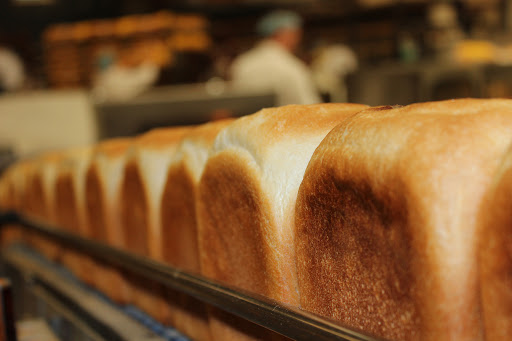
I. Straight Dough Method
Straight dough is a single-mix process of making bread. In this method all the ingredients are mixed together, and the dough is fermented for a predetermined. The fermentation time of straight dough depends on the strength of flour. Strong flours required more fermentation time to mature adequate. It is the least complicate of all dough making processes.
Flours which require 2 to 3 hours for maturing should be used for making bread by straight method. Flours that take very long period for mattering should not be used in straight method. It is is very necessary to control the temperature of a straight dough by-
- Using shorter fermentation periods
- Adjusting the temperature of doughing water
- By fermenting the dough at optimum (room) temperature i.e. between 78 deg. To 80 deg F.

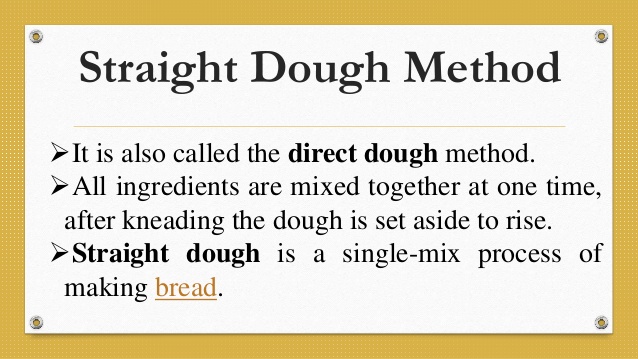
II. Delayed Salt Method
This is a slight variation of straight method, where all the ingredients are mixed except salt and fat. As the salt has a controlling effect on enzymatic action of yeast, the speed of fermentation of a salt less dough will be faster, and a reduction in total fermentation time could be affected. The salt is added at the knock-back stage. The method of adding salt at the later stage may be according to the convenience of individual baker. It may be sifted (dry) on the dough and mixed. It may be creamed with fat and mixed.
- Whatever way is chosen for mixing the salt, only three-fourth (of the actual mixing time) mixing should be given initially and one-fourth mixing at the time of adding salt. The method is especially suitable if strong flours are to be used for bread-making by straight method. Due to absence of salt, the fermentation speed is enhanced and gluten is matured in a reasonably shorter time.
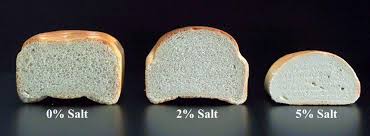
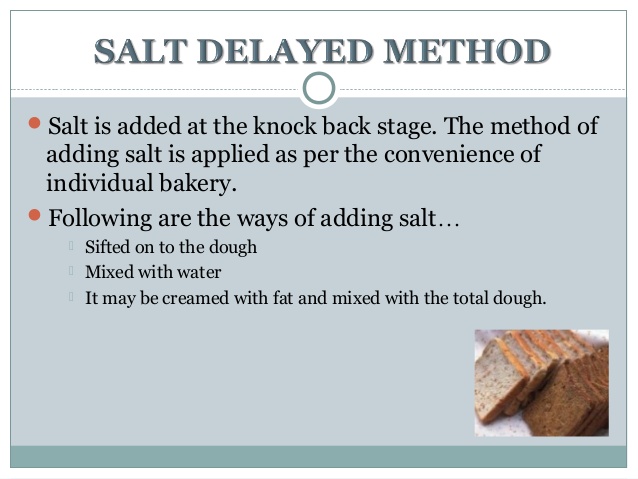
III. No-dough Time Method/No-Time Dough Method
In this method, dough is not fermented in the usual manner. It is just allowed a brief period (about 30min) for it to recover from the strains of mixing. Since dough is not fermented the twin functions of fermentation (i.e. production of gas and conditioning of gluten) are achieved to some extent by increasing the quantity of yeast (2 to 3 times of original quantity) and by making the dough little slacker and warmer.
- Although it is possible to make fairly acceptable bread (during emergency) by using this method the product has poor keeping quality and lacks in aroma. Due to absence of fermentation the gluten and starch are not conditioned sufficiently to retain the moisture and there is no flavour because flavour producing bi-products of fermentation are absent. As there is increased quantity of yeast present, the bread may have a strong yeast flavour.
No time dough method-
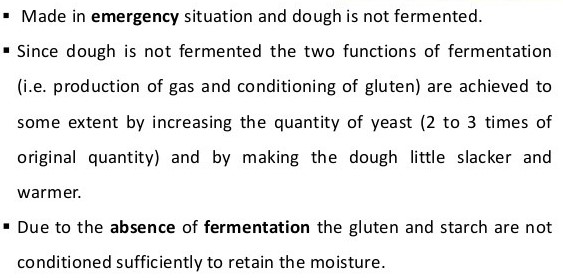
IV. Sponge & Dough Method
Since the strong flours (High in Protein) take too long for conditioning and should not be used for making bread by straight dough method. For such flours sponge and dough method is more suitable where the problem of controlling the dough temperature is not so acute as the total fermentation time is divided in two separate segments.
- A sponge-dough is indicated as 60/40 sponge-dough, where the first numbers i.e. 60 or 70 indicate the percentage of flour used in sponge and the second numbers i.e. 40 or 30 indicate the percentage of flour mixed at the time of dough making.
- When ferment is ready, it is mixed into dough, along with the remaining ingredients and allowed to ferment for the second stage of fermentation before the baking.
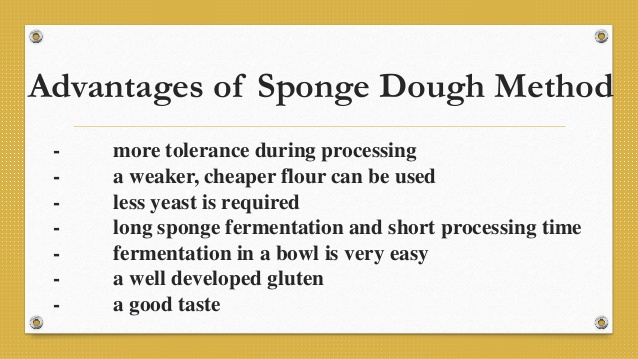
Bread Improver & Emulsifiers
Bread improver is a blend of ingredients that activate the gluten and help produce gas which assists and improves the processes of dough kneading and fermentation. The result is a lighter loaf with better texture and keeping qualities. They are used more often in grain mixes or breads with addition of fruit, seeds or nuts to a loaf to give strength and volume.
Bread improver are classified into 2 types-
- Chemical Improver
- Natural Improver
Example of Chemical Improver
| Potassium Bromate –It reacts with flour and makes the gluten very soft. It reacts with enzymes and gives a shiny texture. It helps yeast activity. Should be used 3 to 4gms for 1kg of flour. It improves the volume, texture and crumb colour. |  |
| Ammonium chloride-Yeast takes this and works very fast. During heating it forms hydrochloric acid and it kills the bacteria. Should be used 5gms on flour weight. |  |
| Potassium iodate–It improves the extensibility of gluten. We should use 5gms on flour weight. | 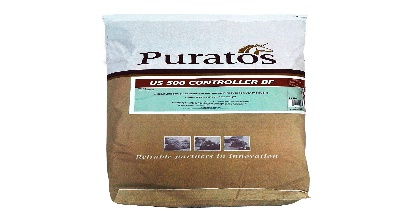 |
| Calcium peroxide-It makes the dough skin dry. Hence it can be utilized in automatic bread plant for moulding, so that dough does not become sticky. We should use 3gms on flour weight |  |
| Calcium Propionate-It controls the rope and mold disease. We should use 3 to 5 gms for 1 kg flour. | 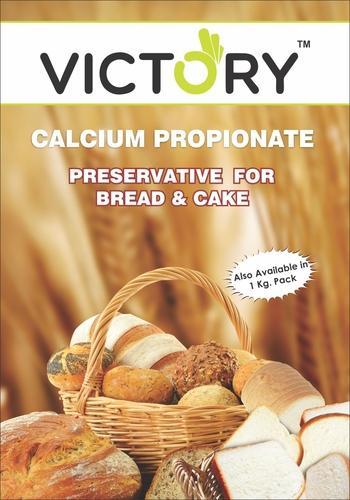 |
| Ascorbic acid-It is an oxidizing agent and it improves the dough stability |  |
Natural Bread Improver-
Milk –It has tightening effect on the flour protein, which improves the texture of products. It improves the flavour and taste. Milk contains lactose. It improves the crust colour and improves the nutritional value. The butterfat present in milk keeps the product moist for a linger time and improves the shelf life. It gives unique buttery flavour to the product.
- Milk can be used for making yeast products in many forms. That is fresh milk, condensed milk evaporated milk and powder form. Milk must be high heat treated for yeast leavened dough otherwise the dough will lack necessary gas retaining ability.
Malt–(is germinated cereal grain that has been dried in a process known as “malting”.)It provides enzymes that convert starch to sugar during fermentation in the dough. It creases the moisture retaining capacity and keeps the product moist and fresh for longer time.
- It has a softening action on gluten, which improves the softness of the crumb, grain, texture, crust colour, higher volume, better taste, better oven spring, and shelf life. The drying effect of milk protein in milk bread is balanced by the use of malt.
Soy flour–Soy flour contains higher quantity of protein. It gives nutritional value to the bakery products. It increases the water absorption power of flour. It has a modifying action on the product crumb, texture and grain. It improves the moisture retention power, toasting characteristic, colour and softness. It also has strengthening effect in the gluten and it improves the product quality. It also has strengthening effect in the gluten and improves the product quality. It increased the oxidation requirement in yeast products and rolls for optimum volume.
What are the various faults could occur while making the breads and what will be its remedies?
| Low volume in bread or Lack of Volume in Breads |
|
| Too much volume in bread |
|
| Low color in bread after baking or dull color bread |
|
| Dark color in bread after baking or over browning of bread |
|
| Irregularity of bread shape |
|
| Holes in Bread |
|
Popular Breads in the world
| Focaccia-A flat Italian bread similar to pizza dough, but rises higher due to a greater yeast content, Focaccia contains quite a bit of olive oil. It’s typically eaten as a side or sandwich bread, often with olive oil, salt, and herbs |  |
| Sourdough–This truly ancient bread is created by fermenting dough using naturally occurring lactobacilli culture and yeast. The method has been traced back to the very beginning of agriculture thousands of years ago. Sourdough retains a mildly sour taste, and keeps better than other kinds of bread. | 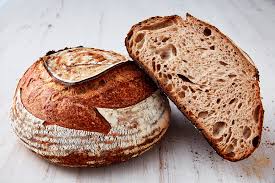 |
| Ciabatta-A recent Italian bread invention, made in response to the rise in popularity of French baguettes, ciabatta is an elongated, broad and flat loaf. There are many different varieties of ciabatta, ranging from a dense to a porous crumb and soft to crunchy crust. A Panini is a toasted sandwich made from ciabatta bread. | 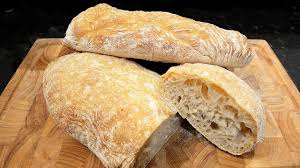 |
| Brioche:-Rising in popularity as a burger bun, brioche is a rich French bread made using butter and eggs. The greater the butter-to-flour ratio of a brioche dough, the more the resulting bread tastes like a pastry or cake. Brioche for use in burgers tends to have a lower butter content, while the more traditional buttery type is used for desserts |  |
| Bagels- These ring-shaped breads originated from Jewish communities in Poland, and remain very popular across the world. Bagels are dense and chewy, often topped with sesame or poppy seeds baked into the surface. They’re usually eaten sliced and toasted with a spread or topping, or used as a sandwich bun. |  |
| Lavash:-An unleavened flatbread eaten either as a soft wrap or as a dried brittle cracker, lavash is made of flour, water and salt rolled out flat and slapped against hot clay oven walls. Lavash is a traditional food in Armenia, Azerbaijan, Turkey, and Iran. |  |
| Pita–slightly leavened wheat-flour dough is rolled out into flat rounds and baked at high temperatures, causing the dough to puff up in layers. After removing the rounds from the oven, the dough deflates but retains separate layers inside. The most common ways to eat pita breads are as a wrap or cut in half and filled. |  |
| Tortilla- A thin unleavened flatbread, tortillas are traditionally made from finely ground maize (corn) but now many are made from wheat. Tortillas are eaten daily in Mexico and are a key ingredient in all kinds of Latin American dishes including tacos, enchiladas, quesadillas, and tostadas. Mexican burritos are usually made with wheat flour tortillas rather than corn types. Corn chips (aka tortilla chips) are made from baked pieces of tortilla. | 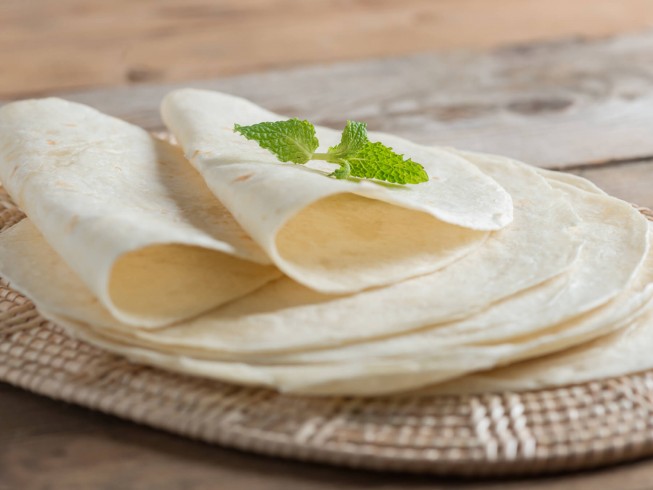 |
| Pulla Bread-The soft, cardamom-spiced pulla is a popular Finnish sweet bread made with rich yeasted dough that is usually served sprinkled with coarse sugar, almonds, or walnuts. | 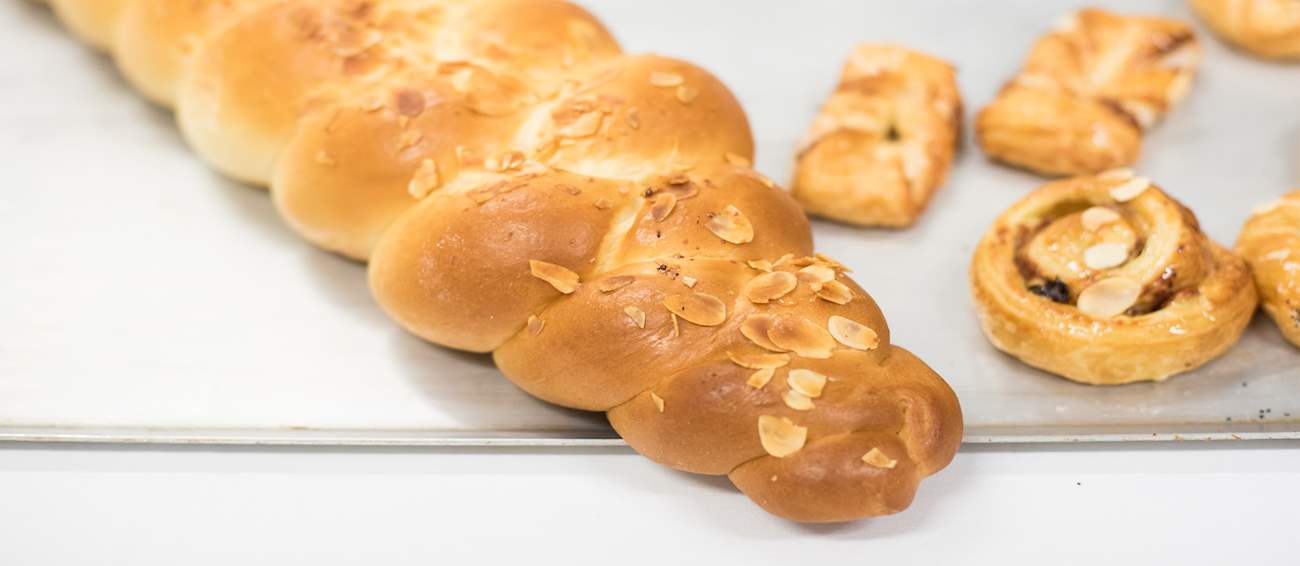 |
| French Baguette-is a long, thin loaf of French bread[2] that is commonly made from basic lean dough (the dough, though not the shape, is defined by French law). It is distinguishable by its length and crisp crust. A baguette has a diameter of about 5 or 6 cm (2-2 1⁄3 in) and a usual length of about 65 cm (26 in), although a baguette can be up to 1 m (39 in) long. |  |
| Michetta -is an Italian white bread, recognizable from its bulged shape. Also known as rosetta, it has a hollow, bulging shape. | 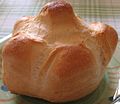 |
| Pumpernickel(German bread) is a typically heavy, slightly sweet rye bread traditionally made with sourdough starter and coarsely ground rye. It is often made today with a combination of rye flour and whole rye grains. |  |
| Whole wheat bread or wholemeal bread is a type of bread made using flour that is partly or entirely milled from whole or almost-whole wheat grains, see whole-wheat flour and whole grain. It is one kind of brown bread |  |
| Zopf or Züpfe Bread– is a type of Swiss, Austrian or Bavarian bread made from white flour, milk, eggs, butter and yeast. The dough is brushed with egg yolk before baking, lending it its golden crust | 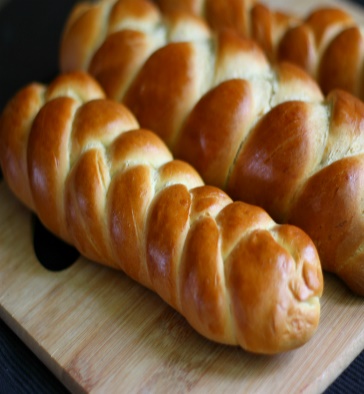 |
| Taftan Bread:-is leavened flour bread from Iranian, Pakistani and Indian cuisines. This bread is made with milk, yoghurt, and eggs and baked in a clay oven. It often flavoured with saffron and a small amount of cardamom powder, and may be decorated with seeds such as poppy seeds. |  |
| Shreemal bread-is a saffron-flavored traditional flatbread from Greater IranThe word sheermal is derived from the Persian words sheer meaning milk, and malidan meaning to rub. In a literal translation, sheermal means milk rubbed. After being introduced to North India by the Persianate Mughal emperors. It became a delicacy of Lucknow, Hyderabad and Aurangabad. It is also part of the Awadhi cuisine and is enjoyed in Old Bhopal. |  |
| Qistibi Bread-is a popular traditional dish in Tatarstan, Bashkortostan and Udmurtia. Qistibi is roasted flatbreads with various fillings inside. The dough should be unleavened. The most popular filling is mashed potato but it may also be ragout or millet. The filling is placed on one half of the flat cake and is covered by the other half. Later, clarified butter is spread on the flat cakes. |  |
List of popular Indian breads from all over the Region:-
Indian bread varieties are as diverse as its regional cuisines. list of breads from different regions of India are:-
Bread from North India
- Roti/Chapati: Commonly made from whole wheat flour.
- Naan: Leavened bread, often cooked in a tandoor.
- Paratha: Flaky and layered, can be stuffed with various fillings.
- Poori: Deep-fried unleavened bread.
- Bhature: Deep-fried, often served with chole (spiced chickpeas).
- Tandoori Roti: Cooked in a tandoor oven.
- Lachha Paratha: Multi-layered and crispy.
- Missi Roti: Made with whole wheat and chickpea flour.
- Makki /Butte di Roti: Flatbread made from cornmeal, typically served with sarson da saag (mustard greens).
- Mandua ki Roti: Made from finger millet flour, often served with vegetable curries.
- Bakarkhani: A type of spiced, flaky bread.
- Kashmiri Naan: Stuffed with nuts and dried fruits, often enjoyed with traditional dishes.
Bread from West India
- Pav: Soft bread rolls, often used for pav bhaji or vada pav.
- Bhakri: Thick, round bread made from various flours (jowar, bajra).
- Thepla: Spiced flatbread made from whole wheat flour, commonly found in Gujarat.
- Kachori: Fried bread often stuffed with spicy fillings (more common as a snack).
- Ker Sangri Roti: A type of bread enjoyed with ker sangri (desert beans and berries).
- Thalipeeth: A multi-grain flatbread made with a variety of flours and spices, often including vegetables.
- Bola: A traditional Goan bread, round in shape and often slightly sweet.
- Sannas: Slightly sweet, fermented goan rice bread often enjoyed with spicy curries.
Bread from South India
- Idiyappam: Steamed rice noodles that can be used as a bread alternative.
- Appam: Soft and spongy pancake made from fermented rice and coconut batter.
- Dosa: A crispy and thin crepe made from fermented rice and urad dal batter.
- Ragi Rotti: A flatbread made from finger millet flour.
- Akki Roti: A rice flour-based flatbread.
- Neer Dosa: Thin and soft crepes made from a rice batter.
Bread from East India
- Luchi: Similar to poori but often made with refined flour, popular in West Bengal.
- Muri: Puffed rice often used as a bread alternative.
- Kachori: Similar to those in the West, but with regional variations in stuffing.
- Chingri Pulao Roti: A lesser-known variant from the region, often used in specialized dishes.
- Pakhala Roti: A type of bread made from fermented rice and flour, served with the traditional Pakhala Bhata (fermented rice).
- Chida Pitha: A rice flour-based bread or cake, sometimes steamed or fried.
- Thekua: A sweet, deep-fried bread made from wheat flour and jaggery, often consumed as a snack or during festivals.
- Litti: A round bread stuffed with spiced sattu (roasted gram flour), traditionally served with chokha (vegetable mash).
- Kodo Ko Roti: Made from finger millet flour, often served with vegetables or meats.
- Kholasapori: A type of rice flour-based bread, often served with curries or vegetables from Assam.
- Apong: A traditional bread made from fermented rice or millet, often consumed with local dishes.
- Khatta: A type of bread made with rice flour, typically served with local stews or curries.
- Bamboo Shoot Roti: Incorporates local bamboo shoots into the bread mixture
Bread from Central India
- Bhutte ka Kees: Corn-based dish that sometimes resembles bread in texture.
- Jowar Roti: Made from jowar flour, common in the central states.
Bread from North-East India
- Khar: Not a bread, but often accompanied by various traditional breads.
- Pitha: A type of rice cake or bread-like preparation, can be steamed or fried, common in Assam and other Northeastern states.
Content Reference:-
The prime moto while preparing the above content is to educate the students who are pursuing carrier in Hospitality & food trade, Hoteliers, chefs, Hotel Management faculty members, Housewife’s etc. The above content has been compiled after referring various culinary books, Research Papers, Research articles, Food magazines, news papers, top culinary websites, Govt websites, personal interaction with renowned chefs from various hotel brands like The Ashok Group of hotel, ITC, Oberai, Leela, Park Hotels & various IHM Faculties, Nutritionists etc. & many more. The picture which i have used has been taken from the open source website .Some of the important website referred for the above content are:-
- https://www.dcmsme.gov.in/old/publications/pmryprof/food/ch1.pdf
- https://www.lib.uidaho.edu/digital/objects/guidedreading/guidedread027.pdf
- https://www.sciencedirect.com/topics/agricultural-and-biological-sciences/breadmaking
- https://www.grantsbakery.co.uk/blogs/bread-the-most-important-thing-in-human-history
- http://www.historyofbread.com/bread-facts/interesting-facts-about-bread/
- https://www.ibec.ie/connect-and-learn/industries/food-and-drink/food-drink-ireland/irish-bread-bakers-association/facts-about-bread-and-how-it-is-made/bread
- https://www.exploratorium.edu/explore/cooking/bread-science
- https://www.allaboutbread.com.au/
